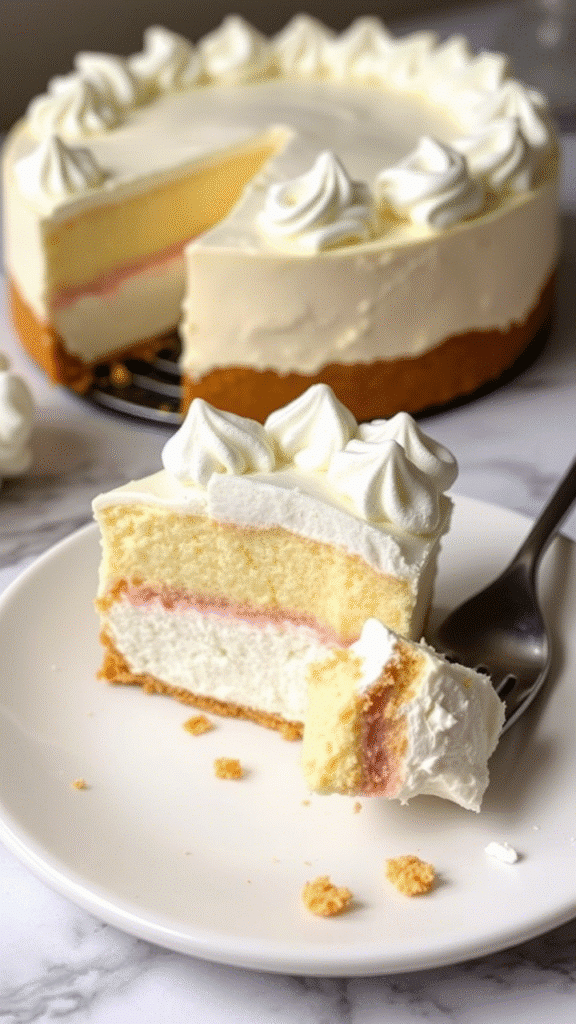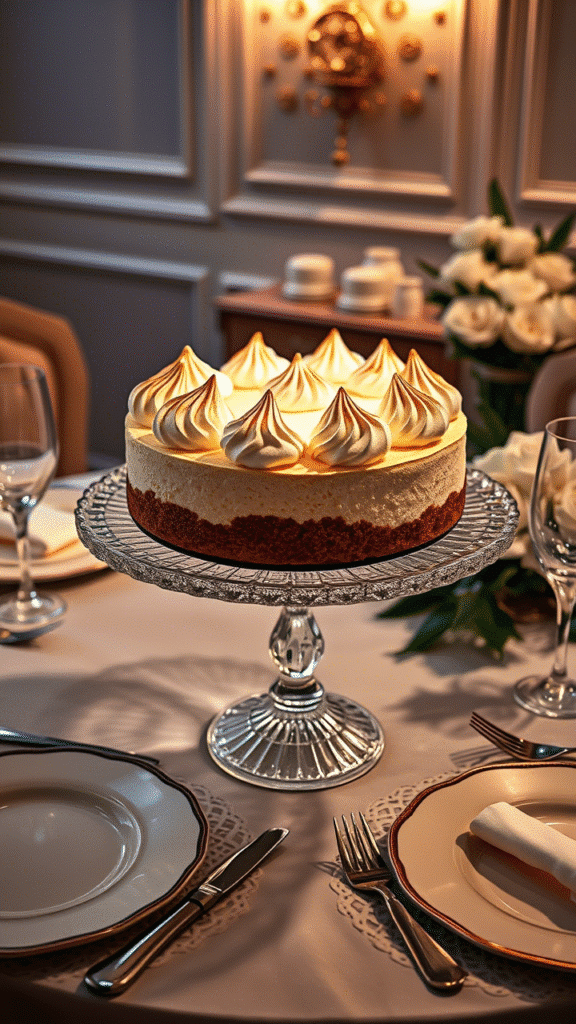I’ll never forget the first time I witnessed a room full of hardened pastry chefs go completely silent. It was during a dessert competition in Paris, and the winning entry wasn’t some elaborate sugar sculpture or molecular gastronomy masterpiece it was a simple, ethereal cheesecake that seemed to float on the plate like a edible cloud.
That dessert was what we now call Marshmallow Whip Cheesecake Heaven, and it’s revolutionized how we think about texture in modern pastry. This isn’t your grandmother’s dense New York-style cheesecake. This is something entirely different a gossamer-light creation that combines the richness of cream cheese with the airy sweetness of marshmallow in ways that challenge everything we thought we knew about cheesecake.
What Makes This Cheesecake Transcendent
The magic lies in the technique. We’re not just folding marshmallows into cheesecake filling and calling it a day. Instead, we’re creating a complex interplay of textures through precise temperature control, careful emulsification, and a technique I call “cloud incorporation” where we fold in fresh marshmallow fluff at exactly the right moment to create maximum volume without losing structural integrity.
The result is a dessert that’s simultaneously rich and light, sweet but not cloying, with a texture that literally melts on your tongue. It’s what happens when traditional cheesecake meets molecular gastronomy, but without the pretension.
Ingredients & Expert Substitutions
For the Graham Cracker Cloud Base:
- 2 cups finely crushed graham crackers (about 16 crackers)
- 6 tablespoons unsalted European butter, melted
- 3 tablespoons granulated sugar
- 1 teaspoon vanilla extract
- Pinch of sea salt
For the Marshmallow Whip Filling:
- 32 oz (4 packages) cream cheese, room temperature
- 1 cup granulated sugar
- 4 large eggs, room temperature
- 1 cup heavy cream, chilled
- 2 cups mini marshmallows
- 1/2 cup marshmallow fluff (store-bought or homemade)
- 2 teaspoons vanilla extract
- 1/2 teaspoon almond extract
- 1/4 teaspoon cream of tartar
- 2 tablespoons cornstarch
For the Heavenly Topping:
- 1 cup heavy cream
- 1/4 cup powdered sugar
- 1/2 cup marshmallow fluff
- Toasted mini marshmallows for garnish
Substitution Intelligence
European butter makes a noticeable difference here it’s higher fat content creates a more tender, flavorful crust. If you can’t source it, add an extra tablespoon of regular butter and a pinch more salt.
For the cream cheese, never use light or reduced-fat versions. The fat content is crucial for proper emulsification. Philadelphia is reliable, but if you can find it, try a artisanal brand with higher fat content.
Mini marshmallows are essential over regular-sized ones because they distribute more evenly and melt at a more controlled rate. If you only have regular marshmallows, chop them into quarters with kitchen shears dipped in cold water.
Those with gluten sensitivities can substitute the graham crackers with gluten-free vanilla wafers or even crushed amaretti cookies for an almond twist.
Step-by-Step Mastery

Preparing the Foundation
Preheat your oven to 325°F. This lower temperature is crucial we’re building texture, not racing to set the filling.
Crush your graham crackers in a food processor until they’re uniformly fine but not powdery. You want some texture remaining. Mix with the melted butter, sugar, vanilla, and salt until the mixture holds together when pressed.
Press this mixture into a 9-inch springform pan, creating an even layer that extends slightly up the sides. Here’s where most people go wrong they don’t press firmly enough. Use the bottom of a measuring cup to really compact it. Bake for 10 minutes, then cool completely.
The Marshmallow Whip Technique
This is where the magic happens, and timing is everything.
Start by beating your room-temperature cream cheese until it’s completely smooth about 3 minutes on medium speed. Scrape down the bowl frequently. Any lumps at this stage will haunt your final product.
Gradually add the sugar, beating until the mixture is light and fluffy. This takes longer than you think about 5 minutes. Don’t rush it.
Add eggs one at a time, beating just until incorporated. Overbeating at this stage can cause cracking later.
In a separate bowl, whip the chilled heavy cream to soft peaks. Set aside.
Here’s the critical step: In a small saucepan, gently heat the mini marshmallows with 2 tablespoons of water over low heat, stirring constantly until they’re completely melted and smooth. This creates what I call “marshmallow silk.”
Let this cool for exactly 3 minutes not longer, or it’ll seize when you add it to the cream cheese mixture.
The Cloud Incorporation
Slowly drizzle the warm marshmallow silk into the cream cheese mixture while beating on low speed. The mixture should become noticeably lighter in color and texture.
Fold in the marshmallow fluff in three additions, being gentle but thorough. Then fold in the whipped cream in the same manner. The key is maintaining that airy texture we’ve worked so hard to create.
Sift the cornstarch and cream of tartar together, then fold this in last. This helps stabilize the structure without weighing it down.
The Gentle Bake
Pour the filling into your prepared crust. The mixture should be voluminous and pale almost cloud-like.
Bake at 325°F for 55-65 minutes. Don’t open the oven door. The center should still have a slight jiggle when you gently shake the pan.
Turn off the oven and crack the door open. Let the cheesecake cool in the oven for 1 hour, then remove and cool completely before refrigerating.
The Science Behind the Clouds
The texture transformation happens through controlled protein coagulation. When we heat the marshmallows, we’re breaking down their gelatin structure, then rebuilding it within the cream cheese matrix. This creates microscopic air pockets that give the cheesecake its ethereal quality.

The cream of tartar acts as a stabilizer, preventing the proteins from over-coagulating and creating a rubbery texture. The cornstarch provides additional structure without heaviness.
Temperature control is crucial throughout. Too hot, and the proteins seize. Too cold, and the marshmallow components won’t integrate properly.
Serving & Presentation Excellence
This cheesecake is best served at cellar temperature slightly cooler than room temperature but not refrigerator-cold. This allows the marshmallow flavors to bloom while maintaining the light texture.
For the topping, whip the cream to soft peaks, then gently fold in the powdered sugar and marshmallow fluff. Pipe or dollop onto individual slices just before serving.
Garnish with toasted mini marshmallows use a kitchen torch for best results. The contrast between the caramelized exterior and soft interior adds another textural dimension.
Perfect Pairings
This dessert pairs beautifully with espresso or dark roast coffee the bitter notes balance the sweetness perfectly. For wine lovers, try it with a late-harvest Riesling or even a cream sherry.
Fresh berries work wonderfully, especially strawberries or raspberries. Their acidity cuts through the richness while complementing the vanilla notes.
For a more sophisticated presentation, dust with cocoa powder or drizzle with a high-quality chocolate sauce just before serving.
Troubleshooting Common Disasters
Cracked surface? Your oven was too hot, or you opened the door during baking. Next time, use an oven thermometer and practice patience.

Dense texture? Either your cream cheese wasn’t at room temperature, or you overbeat the eggs. Room temperature ingredients are non-negotiable for proper emulsification.
Grainy texture? The marshmallow silk was too hot when added. Let it cool longer next time.
Sunken center? Under baked. The center should still jiggle slightly when done it’ll continue cooking as it cools.
Creative Variations That Work
Chocolate Marshmallow Heaven: Add 1/4 cup cocoa powder to the filling and use chocolate graham crackers for the crust.
S’mores Style: Incorporate crushed chocolate chips and use a chocolate cookie crust.
Seasonal Twist: Add a tablespoon of pumpkin pie spice in fall, or peppermint extract during winter holidays.
Fruit-Forward: Fold in freeze-dried strawberries or raspberries for concentrated flavor without added moisture.
The Final Word
Marshmallow Whip Cheesecake Heaven isn’t just a dessert it’s a masterclass in texture manipulation and flavor balance. The techniques you’ll master here will elevate your entire pastry game.
Remember, great pastry is about understanding your ingredients and respecting the process. Every step in this recipe has a purpose, from the temperature of your cream cheese to the timing of the marshmallow incorporation.
Don’t be discouraged if your first attempt isn’t perfect. Even experienced pastry chefs took several tries to master this technique. The key is understanding why each step matters, then adjusting accordingly.
Most importantly, taste as you go. Your palate is your best guide, and every kitchen is slightly different. Trust the process, but also trust yourself.
Frequently Asked Questions?
Q: Can I make this cheesecake ahead of time?
A: Absolutely! In fact, it’s better the next day. The flavors meld beautifully overnight, and the texture becomes even more ethereal. Just add the topping and garnishes right before serving.
Q: Why does my cheesecake crack even when I follow the recipe exactly?
A: Cracking usually happens due to temperature shock. Make sure all your ingredients are at room temperature before starting, and don’t open the oven door during baking. Also, check your oven’s actual temperature with a thermometer many run hot.
Q: Can I freeze this cheesecake?
A: Yes, but freeze it without the topping. Wrap tightly in plastic wrap and aluminum foil. Thaw in the refrigerator overnight, then add fresh topping before serving. The texture will be slightly different but still delicious.
Q: What’s the difference between marshmallow fluff and melted marshmallows?
A: Marshmallow fluff has a different texture and stability than melted marshmallows. The fluff provides immediate lightness, while the melted marshmallows create structure. Both are necessary for the signature texture of this cheesecake.
Q: My marshmallow silk seized up when I added it to the cream cheese. What went wrong?
A: The marshmallow mixture was likely too hot. It should be warm but not steaming when you add it. Also, make sure you’re adding it slowly while beating dumping it in all at once can cause seizing. If this happens, you can sometimes save it by adding a tablespoon of warm cream and beating vigorously.

Veronica is a passionate food enthusiast with over three years of experience in exploring and writing about diverse cuisines. Her expertise lies in reviewing restaurants, sharing creative recipes, and discovering the latest food trends. As the voice behind FoodieRecap.com, Anju brings fresh perspectives and culinary insights to her audience.
